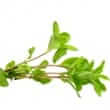Background
- Sweet marjoram is a perennial herb used around the world medicinally and is also grown for its aromatic leaves, which are used in herbal culinary mixtures, such as herbes de Provence and za'atar. The essential oil is noted as having a sweet and spicy aroma.
- Sweet marjoram has traditionally been used to relieve muscle spasms, insomnia (inability to sleep), nausea, and headaches. In aromatherapy, marjoram is used to purportedly help calm individuals who have feelings of emotional instability or who are prone to hysteria or irritability. In early research, sweet marjoram has been studied for its effects in relieving symptoms of asthma, eczema, and skin irritation.
References
- Anderson, C, Lis-Balchin, M, and Kirk-Smith, M. Evaluation of massage with essential oils on childhood atopic eczema. Phytother Res 2000;14(6):452-456.
View Abstract - Benito, M, Jorro, G, Morales, C, et al. Labiatae allergy: systemic reactions due to ingestion of oregano and thyme. Ann Allergy Asthma Immunol 1996;76(5):416-418.
View Abstract - Campanella, L, Bonanni, A, Favero, G, et al. Determination of antioxidant properties of aromatic herbs, olives and fresh fruit using an enzymatic sensor. Anal Bioanal Chem 2003;375(8):1011-1016.
View Abstract - Dorman, HJ, Bachmayer, O, Kosar, M, et al. Antioxidant properties of aqueous extracts from selected lamiaceae species grown in Turkey. J Agric Food Chem 2-25-2004;52(4):762-770.
View Abstract - Esiyok, D, Otles, S, and Akcicek, E. Herbs as a food source in Turkey. Asian Pac J Cancer Prev 2004;5(3):334-339.
View Abstract - Farkas, J. Perioral dermatitis from marjoram, bay leaf and cinnamon. Contact Dermatitis 1981;7(2):121.
View Abstract - Gutierrez, J, Barry-Ryan, C, and Bourke, P. Antimicrobial activity of plant essential oils using food model media: efficacy, synergistic potential and interactions with food components. Food Microbiol 2009;26(2):142-150.
View Abstract - Kim, MJ, Nam, ES, and Paik, SI. [The effects of aromatherapy on pain, depression, and life satisfaction of arthritis patients]. Taehan Kanho Hakhoe Chi 2005;35(1):186-194.
View Abstract - Kuriyama, H, Watanabe, S, Nakaya, T, et al. Immunological and Psychological Benefits of Aromatherapy Massage. Evid Based Complement Alternat Med 2005;2(2):179-184.
View Abstract - Leeja, L and Thoppil, JE. Antimicrobial activity of methanol extract of Origanum majorana L. (Sweet marjoram). J Environ.Biol 2007;28(1):145-146.
View Abstract - Misharina, TA, Polshkov, AN, Ruchkina, EL, et al. [Changes in the composition of the essential oil in stored marjoram]. Prikl Biokhim Mikrobiol 2003;39(3):353-358.
View Abstract - Ninfali, P, Mea, G, Giorgini, S, et al. Antioxidant capacity of vegetables, spices and dressings relevant to nutrition. Br J Nutr 2005;93(2):257-266.
View Abstract - Tahraoui, A, El Hilaly, J, Israili, ZH, et al. Ethnopharmacological survey of plants used in the traditional treatment of hypertension and diabetes in south-eastern Morocco (Errachidia province). J Ethnopharmacol 3-1-2007;110(1):105-117.
View Abstract - Triantaphyllou, K, Blekas, G, and Boskou, D. Antioxidative properties of water extracts obtained from herbs of the species Lamiaceae. Int J Food Sci Nutr 2001;52(4):313-317.
View Abstract - Yang, YC, Lee, HS, Clark, JM, and Ahn, YJ. Insecticidal activity of plant essential oils against Pediculus humanus capitis (Anoplura: Pediculidae). J Med Entomol 2004;41(4):699-704.
View Abstract







